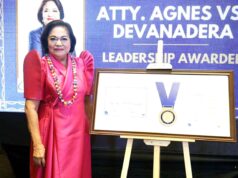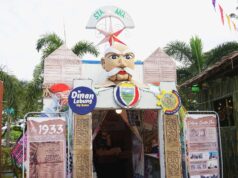CLARK FREEPORT – Officials of the Clark International Airport Corp. (CIAC) said yesterday the bidding last week for the P309-million upgrading of Terminal 1 of the Diosdado Macapagal International Airport (DMIA) here was aboveboard amid threat of a congressional inquiry on allegations it was rigged.
“But for the sake of clearing the air of any doubts on the integrity of the bidding conducted, we would welcome any inquiry to be made by Congress and we would assure them of our utmost cooperation,” said CIAC Executive Vice President Alexander Cauguiran.
This, after Pampanga 1st District Rep. Carmelo Lazatin told Punto he would initiate a congressional inquiry into reports that the bidding for the P309-million project, which was finished Friday last week, was rigged. Araja Construction won in the bidding as its only other competitor was disqualified on technical grounds, he said.
Lazatin claimed that Araja was initially provided by a CIAC official with a list of required equipment for the terminal project. This enabled the contractor to get assurance from a supplier in the United States that the equipment could be delivered in time for a very limited timetable for project completion that discouraged other potential bidders, he said.
Cauguiran said the only other bidder, who was not immediately identified, lost in last Friday’s bidding for “incomplete submission of technical requirements”.
But he insisted that “nothing was rigged, everything was done above board. The bidding followed the prescribed rules and regulations of a competitive public bidding pursuant to R.A. 9184 or the Government Procurement Reform Act.”
“We made sure everyone interested to make a bid for the project had a chance to participate, that’s why we advertised our invitation to bid in not one but two of the most widely read national dailies in the country today, including the Philippine Star,” he said.
Cauguiran said the terms of reference (TOR) for the project “was available to all contractors interested in making a bid.”
“It is not true that there were bidders who were not given the list of needed equipment. That is just impossible because everything must be written in the TOR, including the list of equipment, otherwise we won’t be able to demand the delivery of the equipment from a winning bidder,” he stressed.
The losing bidder, he said, has filed a motion for reconsideration before CIAC’s bids and awards committee (BAC).
“Pending the resolution of the motion by the BAC and the (CIAC) board, the contract can’t be awarded yet (to the winning bidder),” he added.
Cauguiran also justified “the urgency of the need to expand the DMIA Terminal 1”, as he noted that “CIAC on its own conducted inquiries and research on how to fast-track the procurement and delivery of necessary equipment, especially the passenger boarding bridges.”
He said “we found out that from the date they are ordered to their manufacture and assembly and up to their shipment and delivery, the whole process of procuring the passenger boarding bridges will take about six months.”
“But then, if the bridges were available on stock, the delivery and installation will just take about three months. There are many manufacturers of these bridges from different countries. That is why interested bidders may source or order these bridges anywhere in the world,” he said.
Cauguiran said that CIAC’s TOR for the project “contain the construction schedule and target delivery dates of passenger boarding bridges.”
He said that studies on the project revealed that it could be finished in the first quarter of 2010.
Cauguiran stressed the “urgent need to expand DMIA Terminal 1 from its present capacity of two million passengers to five million passengers per year.”
“We foresee and expect that in the next couple of months, there will be a surge in number of international airlines operating at DMIA, along with sudden increase of the volume of international passenger traffic. We also now badly need to have at least two or three passenger boarding bridges to be able to accommodate the long-haul carriers that will start to fly in and out of DMIA,” he noted.
“But for the sake of clearing the air of any doubts on the integrity of the bidding conducted, we would welcome any inquiry to be made by Congress and we would assure them of our utmost cooperation,” said CIAC Executive Vice President Alexander Cauguiran.
This, after Pampanga 1st District Rep. Carmelo Lazatin told Punto he would initiate a congressional inquiry into reports that the bidding for the P309-million project, which was finished Friday last week, was rigged. Araja Construction won in the bidding as its only other competitor was disqualified on technical grounds, he said.
Lazatin claimed that Araja was initially provided by a CIAC official with a list of required equipment for the terminal project. This enabled the contractor to get assurance from a supplier in the United States that the equipment could be delivered in time for a very limited timetable for project completion that discouraged other potential bidders, he said.
Cauguiran said the only other bidder, who was not immediately identified, lost in last Friday’s bidding for “incomplete submission of technical requirements”.
But he insisted that “nothing was rigged, everything was done above board. The bidding followed the prescribed rules and regulations of a competitive public bidding pursuant to R.A. 9184 or the Government Procurement Reform Act.”
“We made sure everyone interested to make a bid for the project had a chance to participate, that’s why we advertised our invitation to bid in not one but two of the most widely read national dailies in the country today, including the Philippine Star,” he said.
Cauguiran said the terms of reference (TOR) for the project “was available to all contractors interested in making a bid.”
“It is not true that there were bidders who were not given the list of needed equipment. That is just impossible because everything must be written in the TOR, including the list of equipment, otherwise we won’t be able to demand the delivery of the equipment from a winning bidder,” he stressed.
The losing bidder, he said, has filed a motion for reconsideration before CIAC’s bids and awards committee (BAC).
“Pending the resolution of the motion by the BAC and the (CIAC) board, the contract can’t be awarded yet (to the winning bidder),” he added.
Cauguiran also justified “the urgency of the need to expand the DMIA Terminal 1”, as he noted that “CIAC on its own conducted inquiries and research on how to fast-track the procurement and delivery of necessary equipment, especially the passenger boarding bridges.”
He said “we found out that from the date they are ordered to their manufacture and assembly and up to their shipment and delivery, the whole process of procuring the passenger boarding bridges will take about six months.”
“But then, if the bridges were available on stock, the delivery and installation will just take about three months. There are many manufacturers of these bridges from different countries. That is why interested bidders may source or order these bridges anywhere in the world,” he said.
Cauguiran said that CIAC’s TOR for the project “contain the construction schedule and target delivery dates of passenger boarding bridges.”
He said that studies on the project revealed that it could be finished in the first quarter of 2010.
Cauguiran stressed the “urgent need to expand DMIA Terminal 1 from its present capacity of two million passengers to five million passengers per year.”
“We foresee and expect that in the next couple of months, there will be a surge in number of international airlines operating at DMIA, along with sudden increase of the volume of international passenger traffic. We also now badly need to have at least two or three passenger boarding bridges to be able to accommodate the long-haul carriers that will start to fly in and out of DMIA,” he noted.




